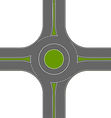





Services
Two categories comprise the suite of services provided by Jeff Waller Consulting:
Traffic Planning and Municipal Engineering.
Any project can contain one or more of these categories and their services.
Below are descriptions of these categories and services that Jeff Waller Consulting provides:
Traffic Planning
At Jeff Waller Consulting, Traffic Planning is the basis of all that we do. The area of Traffic Planning encompasses a wide range of services, including the following:
Many of these services can also be performed for city and county governments or incorporated into a complete Traffic Impact Analysis for a proposed development.


Traffic Impact Analysis
A Traffic Impact Analysis - sometimes called a Traffic Operations Evaluation - is a method most cities and counties use to evaluate a development project. It typically combines various aspects of traffic engineering analysis into a complete evaluation of a project - traffic activity, intersection and segment operations, evaluation of the project site layout, impact assessment, etc. Traffic Impact Analyses are typically customized to include the specific components that a city or county wishes to assess about a project, so each one is unique in content. The staff at Jeff Waller Consulting has prepared hundreds of traffic impact analyses - large and small - and can fully evaluate any project.
Some Traffic Impact Analyses can evaluate many aspects of a project, while other simply focus on just a few. Working with your government jurisdiction, Jeff Waller Consulting can identify what the necessary components are for your project. Jeff Waller Consulting can also structure Traffic Impact Analyses into pieces, only evaluating certain aspects of a project while deferring others until they are requested by the city or county evaluating your project.




Parking Analyses
Nearly all development projects most provide vehicle parking - whether it may be on the project site or just on-street parking. Jeff Waller Consulting can determine the required number of parking spaces per your agency's requirements as well as verify that your site plan or layout meets those same requirements. For project with multiple land uses, Jeff Waller Consulting can also evaluate how the parking on a project site would be shared between said uses, especially if those uses have their peak parking activity as separate times. For example, a project with both apartments and retail uses would have its peak parking activity during the evening and early morning (i.e., when its residents are all home), yet its retail uses would have their peak parking activity during the mid- to late afternoon. A sharing of the parking supply between both uses could reduce the total number of necessary on-site parking spaces while providing sufficient parking spaces for both uses.
Site Distance Evaluation
Sight Distance, at its core, is the ability for conflicting traffic flows to identify each other and avoid a collision. Conflicting traffic can include vehicles, pedestrians, or bicyclists. At intersections and driveways, adequate sight distance provides sufficient distance for through traffic to completely stop when conflicting traffic enters the intersection. In this manner, the frequency and severity of collisions can thereby be reduced. Using Caltrans procedures and standards, sight distance can be measured and evaluated for all intersections and driveways. Obstructions to sight distance - be they landscaping, trees, street light poles and signposts, utility poles, or other impediments - can also be identified.
Jeff Waller Consulting can provide sight distance evaluation services as either a stand-alone service or as part of a complete Traffic Impact Analysis. This service can be performed at either existing driveways and intersections or as a part of new developments.

Unique/Custom Trip Activity
Sometimes a project is unique. Maybe it's a manufacturing facility with a late evening or early morning shift start time. Maybe it's a commercial use that is different from other uses in the area. Maybe it's an agricultural housing or processing facility to different operating hours from other uses in the area. Whatever the case, Jeff Waller Consulting can handle these types of projects. The potential operations of a project are key to understanding its trip activity, especially if it's an atypical project. By crafting the trip generation estimate to reflects the actual project, Jeff Waller Consulting can identify if either typical or customized trip activity rates are applicable. In this way, we can identify whether a project would actually add traffic during the typical morning and evening high-traffic periods, as well as if additional improvements are required during other parts of the day (e.g., intersection and driveway lighting, warning signs, etc.).

Municipal Engineering
Municipal Engineering encompasses the many services that Jeff Waller Consulting can aid cities and counties in performing, either as a one-time endeavor or as an extension of governmental staff. Below are the many services that we offer:
Development Review
A large, proposed development will involve the creation of multiple types of intersections and conflicting flows within its boundaries. This can include various intersection controls, pedestrian crossings, bicycle facilities, and vehicle turn lanes. Other traffic engineering aspects include turn lane vehicle storage lengths, pedestrian and bicycle circulation across the site, and interfaces/transitions between the project site and existing infrastructure. It is important that these facilities and aspects be reviewed in order for them to operate acceptably immediately after the development is completed. Jeff Waller Consulting can perform this review, either as a part of the project site team or as an extension of governmental staff. This review could include topics such as which street may need formal bicycle lanes, which intersections will need to be signalized or all-way stop control, whether roundabouts would be an option, and walking paths to existing or proposed schools, parks, and commercial uses.
Complete Streets Analysis
A Complete Streets Analysis focuses on a balanced set of infrastructure for all modes of travel - vehicle, pedestrian, bicyclists, and transit. Balance is the key word here - not all roadways have sufficient width to provide all infrastructure for all travel modes. Context is also important. In an urban downtown commercial district, pedestrian and bicycle activity is very high, hence wide sidewalks, frequent crosswalks, and separate bicycle lanes are important if not mandatory. In a more suburban setting, most circulation is by automobile, but pedestrian and bicycle circulation are important to maintain pedestrian and bicycle feasibility and safety amongst the multitude of higher-speed vehicles.
Small improvements can also improve the safety and accessibility of pedestrian and bicycle circulation. Improvements, such as intersection bulbouts (roadway narrowing at intersections), crosswalks, sidewalks, bicycle lane buffers (striped or raised separations between bike and vehicle lanes), or other improvements to aid roadway crossings or visibility, can improve the viability or shorter travels to schools, parks, and nearby commercial areas.
Jeff Waller Consulting understands firsthand why complete streets are important. As pedestrians and bicyclists ourselves, we are intimately aware of both the importance of providing facilities for all people, no matter which travel mode they choose. That's why we listen to the needs of all users - vehicles, pedestrians, and bicyclists alike. This achieves a balanced approach that is beneficial to everyone.









Peer Review
A Peer Review is a review of a Traffic Impact Analysis for soundness of approach, consistency with city/county policies, and appropriateness of recommendations. These are typically employed by cities and counties to ensure that all associated transportation and policy issues are addressed appropriately.
The staff of Jeff Waller Consulting have performed many Peer Reviews over their lifetimes for various cities and counties across California. As we prepare Traffic Impact Analyses ourselves, we know the components and issues that these projects can and should contain. This gives Jeff Waller Consuolting specialized insight into what a Traffic Impact Analysis should and should not be. We also realize that not all projects and Traffic Impact Analyses are the same, and thus should be reviewed in the context of what analysis aspects are truly necessary and which are not. In this manner, Jeff Waller Consulting uses a more balanced approach when performing a Peer Review.

Infrastructure Feasibility and Modification Analysis
The start of every roadway infrastructure project - be it a vehicle capacity improvement, bicycle facility, traffic congestion reduction, or alternatives investigation - starts with a feasibility analysis. Such an analysis can identify if an improvement will improve operations, create new safety issues, or even require further improvements not previously identified. Jeff Waller Consulting can aid client in answering these questions to that the feasibility and net benefits of the design improvement can be determined. While Jeff Waller Consulting primary focuses on the operational aspects of a project, we can also consult with other traffic design companies for a more holistic assessment of a project's design.





Intersection Safety and Operational Assessment Process (ISOAP)
What would be the most appropriate traffic control type for a given intersection? Sometimes, that can be a tricky question to answer. Side-street stop? This is typically the default intersection control. An all-way stop - where all approaches have a stop sign - can be an inexpensive option for intersections with more conflicting vehicle or pedestrian traffic. However, if one of the intersecting streets has a large volume, all-way stop control can induce considerable delays to the intersection. Traffic signal? That can work for intersections with large traffic voulumes, but traffic signals can be expensive to install and have constant electrical and frequent maintenance costs associated with them. A roundabout might work in some instances, but it can also be expensive and may require aquisition of additional land or relocation of existing utilities prior to construction.
That's where an Intersection Safety and Operational Assessment Process (ISOAP) can be a handy evaluation. ISOAP (previously named Intersection Control Evaluation, or ICE) compares the construction and maintenance costs associated with a traffic control operation with the relative collision frequencies, safety benefits, operations, and vehicle emissions to determine what the most beneficial traffic control option would be for a given intersection. ISOAP evaluations also inherently assess the feasibility of an improvement, allowing only a comparison of those traffic control options that can be physically implemented given the construction constrains of an intersection. An ISOAP is also required by Caltrans for any modification of traffic control to a state highway intersection, such as signalization of conversion to a roundabout.
Jeff Waller Consulting is experienced with the preparation of ISOAPs. Teaming with other design engineers or just evaluating conceptual designs, we can identify the most optimal traffic control option for a given situation. Alternatively, Jeff Waller Consulting can also identify if said traffic control option would require considerable added expense to construct (e.g., acquisition of adjacent properties, installation of retaining walls, relocation of existing infrastructure, etc.).





Collision Analysis
Intersections are inherently prone to collisions by their nature. All vehicle movements conflict with pedestrians, bicyclists, and other vehicles. By that measure, all intersections have an innate collision risk. How does one assess the relative safety aspects of an intersection? One method is to review historical collision histories. This type of intersection assessment - a Collision Analysis - identifies all collision types and their locations at an intersection. From such an analysis, collision frequencies can be identified, which can indicate a need for intersection improvements. For example, a high prevalence of broadside collisions - commonly known as T-Bone or right-angle accidents - could indicate a need for traffic control modifications. A frequency of rear-end collisions at a traffic signal may indicate that there is excessive vehicle speeding or oncoming drivers cannot observe vehicles waiting at a signal for a green light. Comparisons to statewide collision averages for collision diagrams can also be helpful in spotting collision trends or frequencies that may be missed otherwise.
Another method for comparing collision frequencies is collection projection. Using the Highway Capacity Manual and Crash Modification Factors (CMFs), one can quantify inherent and future collision frequencies based on roadway or intersection characteristics. Comparisions can be made between the potential collision frequencies of different improvement options and different traffic control types
Jeff Waller Consulting is experienced in using both collision evaluation methods, both as stand-alone projects and as part of a larger analysis efforts (such as Traffic Impact Analyses and Intersection Safety and Operational Assessment Processes (ISOAPs)). We have also performed such evaluations more broadly in citywide contexts that identified intersections with high pedestrian and bicycle collisions.

All-Way Stop Warrant Evaluation
The conversion of an intersection to all-way stop control - also known as multi-way stop control - is an important service for cities and counties to perform. When performed in the right context, a conversion can greatly improve intersection crossing opportunities for vehicles, pedestrians, and bicyclists. However, official state procedures and methodologies must be followed in the all-way stop warrant evaluation. It is also important to document the justification for either recommending or rejecting the all-way stop conversion for public discussions.
Jeff Waller Consulting has performed many all-way stop warrant evaluations for various cities and counties. These evaluations incorporate many other traffic engineering analysis, including intersection operations and delays, collision analysis, and sight distance evaluation. Full documentation of the analysis and its conclusions is included in every review.

Speed Survey
A Speed Survey - officially known in California as an Engineering and Traffic Survey - determines the signed speed limit of a street. Jeff Waller Consulting is well-versed in the preparation of these surveys, including the California-specific rules and methodologies used in speed limit evaluations and determinations. Our evaluations have included both large and small agencies as well as situations where vehicle speeds were collected as part of the evaluation or by the government agency. We can also identify if any California-specific speed limit statues could apply to streets near schools or in downtown commercial districts.

Grant Application Preparation and Assistance
We get it - cities and counties are strapped for cash these days. Funding infrastructure projects is expensive and only getting worse. One way to bridge the funding gap is the grant - an allocation of funding from the state or federal government for certain types of infrastructure improvements. Jeff Waller Consulting can assist in the preparation of grants by providing data and analysis requested in grants, whether it be traffic volumes, operational analysis, or quantification of the benefits of an improvement relative to its construction and maintenance costs. In tandem with transportation design companies, we can also provide the comprehensive analyses that are required in grant preparation.

